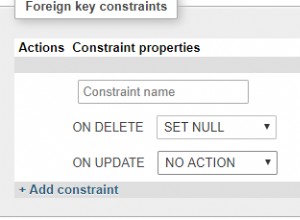La prossima volta, usa una singola istruzione "alter table" per aggiornare la chiave primaria.
alter table xx drop primary key, add primary key(k1, k2, k3);
Per sistemare le cose:
create table fixit (user_2, user_1, type, timestamp, n, primary key( user_2, user_1, type) );
lock table fixit write, user_interactions u write, user_interactions write;
insert into fixit
select user_2, user_1, type, max(timestamp), count(*) n from user_interactions u
group by user_2, user_1, type
having n > 1;
delete u from user_interactions u, fixit
where fixit.user_2 = u.user_2
and fixit.user_1 = u.user_1
and fixit.type = u.type
and fixit.timestamp != u.timestamp;
alter table user_interactions add primary key (user_2, user_1, type );
unlock tables;
Il blocco dovrebbe impedire l'arrivo di ulteriori aggiornamenti mentre lo stai facendo. Quanto tempo ci vuole dipende ovviamente dalle dimensioni del tuo tavolo.
Il problema principale è se hai dei duplicati con lo stesso timestamp.




